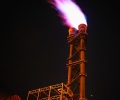‘No intention’ among GECF members to jointly manage gas market

There is “no intention” among the members of the Gas Exporting Countries Forum (GECF) to engage in coordinated market management during periods of low prices, GECF Secretary General Yury Sentyurin said in an interview with S&P Global Platts.
Over the past decade there has been speculation that the GECF could morph into a “Gas OPEC” with the power to manage markets through supply intervention.
But Sentyurin, speaking after the fifth heads-of-state GECF summit in Equatorial Guinea in late 2019, said the group’s role was to encourage gas use and cooperation among its members.
“The GECF has no intention at all to jointly reduce gas/LNG production to balance the market when prices are low,” Sentyurin said, adding: “Technically this is not always possible.”
Instead, Sentyurin said, the gas market tended to return to balance by itself, a reference to the “boom and bust” nature of the market and the need for significant investment in new projects.
“Gas markets are cyclical and experience periods of high and low spot prices due to the time and capital-intensive nature of projects in the industry,” he said.
“Markets have always been able to balance themselves during a period of low prices, which we witnessed in 2019 with Europe acting as a sink market, which drove coal-to-gas switching in the power sector,” he said.
The GECF shares some traits with OPEC, but Sentyurin was keen to dispel the “common misunderstanding” about the GECF being the “Gas OPEC”.
“It is important to highlight that although GECF is an intergovernmental organization of gas exporting countries, somewhat similar to OPEC, our mission and vision as an organization are completely different,” he said.
The GECF — whose members include gas heavyweights Russia, Qatar and Iran — came into being in 2001 and holds around 70% of the world’s proven gas reserves.
It is tasked with keeping track of global gas market developments and promoting the use of gas across the world.
“We continue to vigorously support and promote cooperation among our member countries, engage in dialog between gas producers and consumers and champion the cause to promote the use of gas as a destination fuel,” Sentyurin said.
Asked whether the GECF sees gas as a bridge to a lower-carbon future or as a fuel with a role to play well into the future, Sentyurin said the group was “of the strong belief that gas is a destination fuel, which is here to stay.”
Gas, he said, can play a major role in achieving the UN’s sustainable development goals and the carbon emissions targets of the Paris Agreement.
“We must, therefore, take advantage of this opportunity to continue promoting the use of gas and seek possibilities to reach markets deprived of access to energy,” he said.
NEAR-TERM DEMAND
In the shorter term, the GECF expects gas demand to grow by around 2%-3%/year, which is significantly lower than the growth of around 5% recorded in 2018 — which experienced severe cold weather — but in line with the 2.5%/year growth recorded over the last 10 years.
Sentyurin said a possible slowdown in gas demand growth in the near term would be driven by a number of factors, including: **a return to normal weather conditions;
**lower industrial activity and slower economic growth in China driven by the US-China trade tensions;
**easing of the coal-to-gas switching policy in China;
**the restart of nuclear reactors in Japan;
**less retirement of coal-fired power plants in the US;
**and renewables expansion globally.
He also said that another mild winter in Asia could see gas demand growth “stunted.”
Sentyurin said that, despite these bearish factors, a recovery in gas demand growth in Europe — driven by the influx of LNG — could offset a decline in gas consumption in other countries, particularly Japan and South Korea.
“Significant coal-to-gas switching in the power sector in Europe is expected to repeat itself in 2020 as more LNG volumes come the market,” he said.
“Overall, the GECF believes that there is room for gas to grow more quickly in the near term and there is a dire need for awareness, through policy support for gas, thanks to its role as a fuel of choice in the global transition to a low carbon future,” he said.
2050 DEMAND
The GECF expects gas demand to reach 5.966 Tcm/year by 2050 from 3.924 Tcm in 2018.
“Gas will be the only hydrocarbon resource to raise its share in the global energy mix,” he said, with the GECF predicting market share of 27% by 2050.
The bulk of future demand growth is expected to take place in the Asia Pacific, North America and the Middle East markets, together accounting for about 75% of the total gas increments to 2050, Sentyurin said.
To meet the growing demand for gas by 2050, the GECF calculates that $9.7 trillion in 2018 prices is needed to invest in additional gas production capacity and trade infrastructure compared with $4.3 trillion in 1990-2018.
Sentyurin warned, however, that long-term growth in global gas demand could be impacted by a lack of financing and investment of fossil fuel projects, decarbonization and tightening environmental policies.
Source: Platts

 Hellenic Shipping News Worldwide Hellenic Shipping News Worldwide, Online Daily Newspaper on Hellenic and International Shipping
Hellenic Shipping News Worldwide Hellenic Shipping News Worldwide, Online Daily Newspaper on Hellenic and International Shipping





















 PG-Software
PG-Software